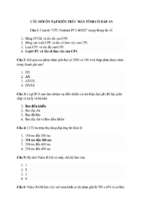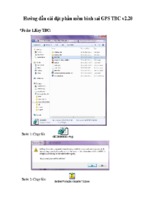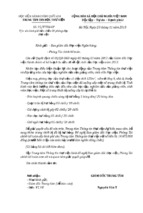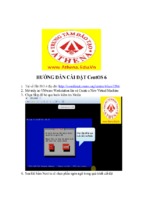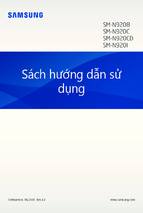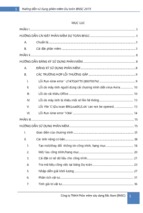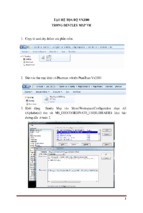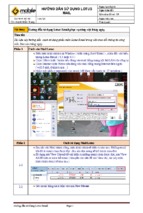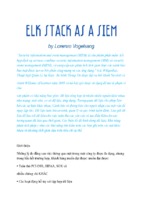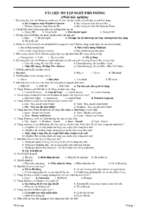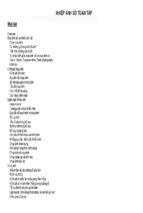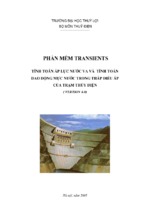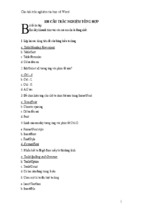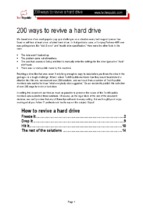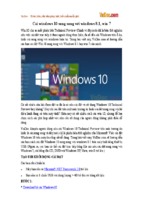200 ways to revive a hard drive
www.techrepublic.com
200 ways to revive a hard drive
We based one of our most popular pop quiz challenges on a situation every tech support person has
faced or will face at least once: a failed hard drive. In that particular case, a Compaq Prolinea 4/66 user
was getting errors like "disk 0 error" and "invalid drive specification." Here were the other facts in the
case:
•
•
•
•
The data wasn't backed up.
The problem came out of nowhere.
The user had accessed Setup and tried to manually enter the settings for the drive type when "Auto"
didn't work.
There was no startup disk made by this machine.
Reviving a drive like that one—even if only long enough to copy its data before you throw the drive in the
garbage—is a tough challenge. When I asked TechRepublic members how they would troubleshoot a
situation like this one, we received over 200 solutions, and we heard from a number of TechRepublic
members who wanted to know “what everybody else suggested.” So we decided to publish this collection
of over 200 ways to revive a hard drive.
In editing this document, we tried as much as possible to preserve the voices of the TechRepublic
members who submitted these solutions. Of course, as the legal blurb at the end of the document
declares, we can't promise that any of these tips will work in every setting. But we thought you'd enjoy
reading what your fellow IT professionals had to say on this subject. Enjoy!
How to revive a hard drive
Freeze it....................................................................................2
Drop it ......................................................................................9
Hit it........................................................................................10
The rest of the solutions ........................................................14
Page 1
200 ways to revive a hard drive
www.techrepublic.com
Freeze it
From: Travis Standen
One trick I have learned as a technician, when the problem is data-read errors off the platters themselves,
is to freeze the hard drive overnight. It makes the data more 'readable,' but for a one-shot deal. If this
data is critical, and you have a replacement hard drive (which, if it's a drive failure, you probably do), then
you can hook up your frozen hard drive and immediately fetch the data off before it warms up.
From: Thedeedj
If the problem is heat related, I put the drive in the freezer for about 15 minutes to cool it down...
sometimes this gets the drive up long enough to copy any critical files...
From: Itguy1
Put the drive in a waterproof sealed bag, put it in the fridge for an hour or so, then have another go.
From: Kelly Reid
Well, I won't start playing with your specific situation, too many steps or possible solutions where
everything starts "If that last thing didn't work try..."
But I'll give you one for free that was a nice hero moment for me. Had a drive where it sounded like the
drive motor was engaging but not getting anywhere, so we stuck it in the office freezer for an hour! I'll be
darned if it didn't work. The drive was up long enough to get the data ghosted to another drive and we
turfed it, even though it sounded fine at that point. I can't really take credit for it though—I had heard it in
some geek bull session but I thought it was some jedi-geek urban myth. Goes to show you that you know
you're really screwed when you say something to the effect of "Okay, hold on tight, I'm gonna try
something I saw in a cartoon once but I'm pretty sure I can do it"
From: mpicpu
If this drive isn't spinning up, putting it in the freezer for about an hour will usually get the drive spinning
again so you can copy needed files before the drive warms up again. The first thing you want to do is run
a disk utility like Norton disk doctor or wddiag (if it's a western digital drive) to verify whether the drive is
working mechanically or not. If it is a master boot record problem, sometimes running Fdisk/mbr will
correct the problem. It could also be a virus, and a program like F-prot will look at the drive as a physical
unit. As an A+ PC technician I have seen this problem many times. Usually if the drive is not making a
clicking sound I am successful in recovering the data.
From: Scott Greving
I've run into this scenario numerous times. One time it involved the main Novell SYS volume on our HP
File Server. I was really sweating as the server would not boot. I took the drive out and put it in a freezer
for 30 minutes. I then reinstalled it into the file server and Presto! I was up and running. Needless to say I
quickly mirrored the drive onto another and got rid of the bad drive.
In stand alone client systems, the method I've had the most luck with reviving drives from death has been
removing the drive, firmly tapping the top of its case several times, and then re-installing it making sure all
cables are secure. I've had a better than 60 percent success rate with this method.
Page 2
200 ways to revive a hard drive
www.techrepublic.com
From: jphillips
If the drive is spinning and you are experiencing these kinds of errors, my experience has been that you
are out of luck.
If the drive is not spinning, I have been able to remove it from the computer and 'spin' the drive on a flat
smooth surface (much like spin the bottle). This will usually free the drive and when placed back in the
machine, it will boot. You should immediately back up you data after a successful boot, because the
problem will return.
The next 'fix' was actually given to me by a Compaq technician several years ago. I had a drive that would
not spin and he told me to put the drive in a plastic bag in the freezer overnight and then install back in
the computer. Believe it or not, the drive booted. I have only tried this the one time.
From: John Turcotte
In the past, when a drive has failed after it has been running for a short period, I have removed it from the
machine and placed it in a freezer for a couple of hours, then hooked it up again. It sometimes will run
long enough to remove the data to another safe storage medium.
From: David Furlow
One of the methods I have used before (sometimes even successfully) is to actually remove the drive
from the PC, place it in the freezer for a day, then quickly put it back in the machine and try to access it.
Why does this work? Who knows, but I heard about this tactic years ago, and it has saved my behind on
a couple of occasions. (Of course, if it comes back up, back up the data immediately.... Guess that should
go without saying.)
From: Keri D.
Hard drive revival:
A technique I have learned is if you bring the temperature of the hard drive down to the freezing point by
putting it in a freezer first and then taking it back out, somehow the condensation from bringing it back to
room temperature helps revive it for about 20 minutes. It can be repeated about 5-6 times tops. Long
enough to get out any important files that need to be backed up. It has been proven to work a number of
times.
From: Christopher Post
How do you bring a hard drive back to life?
My situation:
Half of a volume set goes south on a WinNT server, no good backup and an angry boss screaming about
the data being mission critical.
My solution:
** A bit unorthodox but, it has saved my butt! **
• Turn off the server.
• Take out the failing hard drive and wrap a static bag around it.
• Throw it in the freezer conveniently located in the break room.
• Pray for 1 1/2 to 2 hours.
Page 3
200 ways to revive a hard drive
•
•
www.techrepublic.com
Leaving the hard drive in the bag, quickly plug the drive back into the server. (Just plug the in cables
and go.)
Cross fingers, turn it on, and move all data off the drive as fast as you can! Then add a tape drive and
start backing the dumb thing up!
My so-called logic:
Metal contracts when it is cold.... so the platters shrink and increase the clearance for the read/write
heads.
From: Chris Poole
Put the drive in the freezer for about a week and then you can usually get one last read off the drive.
From: Cheyenne Robert Alspach
Here are some drive recovery tricks that have worked for me, in the order that I do them. Try booting the
drive and copying the data off after every step.
1. Hold the drive upside down, making gravity change the head geometry ever so slightly. Vertical is also
another option.
2. Slightly rap the drive with your knuckle, (but nowhere near hard enough to damage the drive).
3. Try the drive in another machine, (slight drive voltage change assumed to be the miracle worker here).
4. Rap the drive just SLIGHTLY harder than you did above in 2.
5. Freeze the hard drive in the freezer for two hours, and place in a plastic zip lock bag to prevent
condensation from forming on the drive when you plug it back into the system, (head geometry, electrical
resistance lowered, electrical contact points adjusted, etc., assumed to be the miracle here).
6. After the drive warms up to room temperature or better, rap it even harder with your knuckle this time.
7. Repeat all of above steps on next day, as sometimes I've gotten data off drive simply by trying again.
From: James McLaughlin
Hmmm sounds like a toughy to me. Back in the old days when I first started teching, if we ran into a
problem like this, there were only a few ways to deal with it. I will go over these options now:
QUESTION: What do you think you can do about this, Mr. Tech?
First Answe—r—Nothing, your computer is too old, and the data on there is not really of that much
importance. If you really want it back, you can get a hold of a company called "Total Recall" out of Denver
and get charged thousands of dollars to get your files back. Besides, with Y2K, this machine ain’t gonna
run anyway, and prices are so low right now, there is no reason why you should not upgrade now.
2) Well, I can take it back to the shop and pretend like I know what I am doing for 3-6 hours. Then I will
call you the for the next week and a half giving you excuses as to why I am not able to get your
information off of that hard drive. Of course, I won’t charge you anything, but I will expect compensation
for all the time I wasted on your hard drive.
Page 4
200 ways to revive a hard drive
www.techrepublic.com
3) I could take the hard drive out of your machine, plug into my Secondary IDE controller, and boot up.
Hopefully, I can see your hard drive and have the ability to copy all of your files to a temp folder on my
machine called "Your Name." After I collect all information, I would run IBM's WIPE on the drive and then
a thorough scandisk, just to see if the cause was sunspot related or not. If......this was not working, then
extreme temperatures always have a way of talking older hard drives into giving us what we want. I would
then wrap the HD in a Ziplock bag and slam it in the freezer for 12 hours. Pull it out the next day and very
quickly plug it into my machine, copying what I can as quickly as possible until the drive dies again,
repeating until all files are copied and safe. If.....that don’t work, move onto the extreme heat. A Shrink
wrap gun works best, but a hairdryer will do the trick if that is all you have. Wrap one end of the HD in a
towel and use the shrink wrap gun or dryer to heat the hard drive. Very quickly plug it in and copy files
until finished. Repeat until all necessary files are copied and you are done.
You may not think it works, but when you are down to that as your last option...it does.
From: Lichtenwalner Allen L TSgt
Solution:
• Carefully remove it from the computer.
• Place it in the freezer for 24 hours, then put it back in the computer. You should have approximately
30 minutes of good spin time left before a fina–l—and much more permanen–t—shut down.
This problem often arises from a catastrophic hard disk crash—bearings are usually the culprit, coupled
with badly worn read/write heads. I've used this technique on many computers throughout the last fifteen
years as "resident expert" and saved virtually all important data.
If you're in a pinch for time, such as critical data needed for a briefing in twenty minutes, you can opt for
the more drastic cooling technique—a C02 fire extinguisher...
From: Jeff Smoley
Here is a solution for really dead drives: ones that won't spin or ones that make those funny grinding
noises:
Put the drive in the fridge for a few hours. This can shrink up something inside that might let it run long
enough to get critical data. If not, try the freezer for a few more.
This actually has worked for me in the past.
From: Neal Menkus
Things we have done in the past that worked:
1. Remove the drive, grab it, and shake the hell out of it: "What could it hurt? It's not working anyway…."
2. Place the drive in a freezer for about 10 minutes.
3. Open the drive case in a laminar flow-hood, and give it a spin. (Once it was closed up and reinstalled,
it worked long enough to suck the data off of it.)
4. Swap the logic board with one on another drive of the same type.
Numbers 1, 2, and 3 worked with older Seagate (which we no longer purchase) drives, which were prone
to "stiction" problems. Number 4 worked following an electrical surge (lightning strike), since the data on
the platters were still there and OK.
From: Clifford Liles
Depending on the drive failure I have had success with some rather extreme solutions to data recovery.
Page 5
200 ways to revive a hard drive
www.techrepublic.com
Symptom: Invalid Drive Specifications
Treatment:
Basic
Check your cmos battery
Check your IDE cable and connections
Check your jumper settings
Remove all other IDE connections but the drive in question
Advanced
Try disk manager software
Try data recovery software
Use a bios upgrade card ($39) and allow it to setup the drive
Look up the drive specifications on the manufacturer’s Web site and plug
them in manually.
Turn Off or On Write Precomp—32bit disk access
Symptom: Drive does not spin up: "Sticktion"
Treatment:
Basics
Lightly tap the side of the drive case with a screwdrive–r—no power
Lightly tap the side of the drive case with a screwdriver–—power on
Advanced
Symptom: Invalid media type
Treatment:
Basics
Advanced
Cold soak the drive:
Freeze in a zip-lock bag
Spray drive case with inverted can of canned air
Lightly slap the drive on a desk top: (mild frustration)
Repeated hammering of the drive on a desk top: (last resort—total
frustration only)
Boot with a FAT32 Windows 95 boot disk
Sys the drive
fdisk /mbr
Check for a virus from a known clean boot disk
These are but a few techniques for the doomed platters. These techniques can be used in conjunction
with one another to arrive at the desired solution. Lather, rinse, and repeat if necessary.
From: Daniel Philpott
Here is the solutions checklist for this problem:
Tools needed:
• Bootable CD or locked floppy dis–k—Formatted with an OS that can see the file system of the hard
drive. DOS is usually the preferred OS for this function with NTFSDOS from Sysinternals for NTFS
reads and DOS utilities for diagnostics/repair.
• It should have the ability to boot to and/or see CD-ROM drives, read FAT, FAT32, NTFS, or other
common file systems, run common network card drivers and see the network, have disk diagnostic
and/or repair utilities, and have antivirus scanning software with current definitions.
• OnTrack Data Adviso–r—A free download from www.OnTrack.com Hard Drive (large capacity)—
Formatted for a FAT file system (or whatever is your common file system) and preferably with BeOS
as the boot operating system.
• Computer Repair Tool Ki–t—Standard repair tools.
• Freezer–—The one in your kitchen will do quite nicely.
Page 6
200 ways to revive a hard drive
www.techrepublic.com
1. The first task to recovering a drive is not at all technical—It is social. Prepare your user for the worst
but also explain what the realistic chances of recovery are. Then start collecting information that you will
need. Here is what you need to know before starting:
• What is the goal of recovery, returning to the previous state or recovering the data?
• Which is most important?
• What is the client willing to spend on recovery?
• What OS (NT, 95, Linux) and DOS (FAT, NTFS, FAT32) was the system running?
• Where is the computer located?
2. Check the environment: The last question from step 1 is often forgotten and can lead to extensive
troubleshooting of a simple problem. Look for an environmental problem that may cause problems for the
hard drive. Are there magnets on the computer case close to the hard drive? Is there a fan or heater near
the computer? Is a transformer, electrical junction box, or high energy device near the computer (on a
floor above or in a nearby wall)? All of these will produce a magnetic (or electromagnetic) field that can
cause problems. Equipment that may vibrate the computer even at a very low frequency can cause hard
drive heads to skip and jump or even scratch the platters.
3. Turn off the computer, remove the cover, and get ready to the turn the computer on. Then put your ear
right next to the drive and power the system on. If you hear any kind of grinding, scratching, or rattling
from the drive, turn the computer off as quickly as possible and go to the next step. Otherwise go on to
step 5.
4. If the disk has made noise that indicates some sort of mechanical stress, then the problem is the
domain of data recovery experts. This is where the client has to make a decision. Do they want to send
the drive to a data recovery service, or do they want to destroy the disk in an attempt to recover some
data? If the client has information that absolutely needs to be recovered, then send it to the professionals.
Remember, you cannot service a hard drive unless you are working in a clean room.
If they are willing to destroy the disk and try to get some data off the drive, there is a quick hack available.
Place the drive in a static-free bag, then place the drive and static-free bag into a ziplock bag to seal out
moisture. Place this into a freezer turned to as low as possible for 24 hours. After 24 hours, pull the drive
out and immediately put it into a computer (the faster the better) that boots to a floppy and has another
hard drive to transfer data to. If the drive wasn't damaged too much previously, you should be able to pull
some data off before the metal of the drive heats up and starts destroying the data storage platters. You
can repeat the process only if you shut down almost immediately and go through the 24 hour freeze
process again. Chances are that the first time attempt will be the only chance to recover data.
5. If the drive boots to an operating system and you can get to either a net work or backup medium, then
start copying the most important data off first. Once that data is off, you can back up less important data.
The best bet is to listen to your client to find out what absolutely must be recovered.
6. If the client wants to restore the drive to its previous state and continue operating, then you need to do
two things to see if this is feasible.
• First, run a virus scan on the drive. Update the virus definitions then scan every file on the computer.
• Second, boot to a floppy-disk-based hard drive utility and run a low-level
bad sector discovery utility.
If both tests pass and the computer boots to the operating system, then your job is done and you are
eligible for a pat on the back. Otherwise, continue.
7. If the drive does not boot, then try booting to a bootable CD or a bootable locked floppy disk. If you can
see the file system, continue to step 8.
Page 7
200 ways to revive a hard drive
www.techrepublic.com
If you can not see the file system, then assess your tools. If you have Hard Drive Mechanic from Higher
Ground Diagnostics or Tiramisu from OnTrack, then you can use these to diagnose and recover data.
Otherwise, boot to the Data Advisor disk to find out whether data can be recovered. They will recover it or
suggest a recovery plan or even require the disk be sent to a data recovery center like OnTrack. The
client needs to make the choice as to whether the expense of this solution is worth the recovery of the
data.
8. If you can see the file system, then priority actions are:
•
•
•
•
Copy the most important data off the drive
Copy the rest of the data off the drive
Determine if the drive can be recovered (scan with virus checker and disk utilities)
Repair the operating system
The best way of doing this is to install your spare hard drive in the computer and boot to either it or the
CD/floppy bootable. Copy the important data off first, copy the less important data off next, and then do
your diagnostics. If your diagnostics look like the drive is repairable, then go right ahead and repair it.
The reason I suggest BeOS be the boot OS on the hard drive is that it has the ability to mount more file
systems than I even knew existed before using it. If you need to access an exotic file system, BeOS 4.5 is
almost sure to have a driver available for it. However, the FAT (or FAT16) is the most commonly readable
file system around, so generally you will want to transfer data to this file system.
If it becomes apparent that the file system is intact and not infected with a virus (or has had a boot sector
virus removed), then you may need to replace the Master Boot Record (MBR) of the drive. Simple. Boot
to a DOS disk that has the fdisk utility and run an 'fdisk /MBR' to replace the MBR. Remember, balance
the time it takes to restore the operating system against the time it takes to recover data, get a new drive,
and install a fresh operating system.
Normally, disk recovery is simply a matter of recovering the data. Returning a drive to its previous state is
a goal but may simply be more costly than recovering the data and replacing the drive. How much effort
to expend on the process is entirely up to you and the client.
Page 8
200 ways to revive a hard drive
www.techrepublic.com
Drop it
From: Bob Matott
Besides the typical use of sys C: to transfer back the system files deleted during "housecleaning" by
typical users, I've gotten lucky by turning the drive upside down and setting it on top of the power supply
(which seemed to remove "a static charge" that had built up).
Also have used various Disk Manager packages to "talk" to drives with FAT/NTFS corruptions just to
recover the data. If drives are being reformatted from an operating system that doesn't want to "fully go
away" (can name a few!), the disk manager software has also worked in this scenario many times to get
rid of the old and allow you to reformat with the new.
Of course, there's always the "drop it from 4-5" onto a flat hard surface" or "smack the side of the
case with the flat of your hand" approaches. Believe it or not, both techniques have worked. Rumor has
it that sometimes the heads "stick" to the platters during parking/cooldown.
From: Kenneth Lillemo
Sometimes a hard drive that has been running since nearly forever won't spin up after being shutdown for
a while. This can be caused by the heads sticking to the platter. As a LAST resort, I will drop the drive
onto a firm surface from approximately eight inches. Inevitably, this will solve the problem and the
drive is useable long enough to remove the data. My Sys admin spouse gives me a funny look every time
I do it but can't argue with the results.
From: Peter Tello
If the low level diagnostics fail, I declare it officially dead. At that point, I have nothing to lose, so I pull it
out and over a thin carpet, drop it 6" squarely on all 4 sides, repeating this 2 or 3 times. I have
approximately a 50 percent successful boot-up rate, usually enough to copy the data off and save my
behind for not having it backed up in the first place.
From: TDC Tech
This is a one-time fix—long enough to revive HD to get data.
• Take the HD out of the computer and squarely drop it on the closed side of the drive (to your
bench) with perhaps a little slam.
• This seems to free up the bearings long enough to copy data off of the hard drive. I have quite a bit of
luck, but 90 percent of the time it only works once.
Page 9
200 ways to revive a hard drive
www.techrepublic.com
Hit it
From: Karen_Roman
1. Check CMOS settings to make sure the drive setting are what they should be—the CMOS battery
could be dead or the user may have changed the settings. A bad hard drive could cause the Autodetect
to misread settings.
2. Boot from a floppy disk and run fdisk/mbr to restore the backup copy of the master boot record.
3. Image the drive with drive copy program to a new drive.
4. It’s possible the HDD controller is bad. Try the drive in another machine.
5. Boot from a floppy attach to a network drive or have a secondary drive installed and if you can access
the data copy it off to there.
6. The drive could have a stiction problem. Tap it gently on the sides, preferably with a rubber mallet.
From: Alan Gates
As "unscientific" as this sounds, I have found that rapping the drive case a couple of times sometimes
allows the drive to come up. I have had several experiences in the past like this. Sometimes the drive is
having trouble "spinning up." Obviously, the drive is on its last legs but a rap on the drive case will
sometimes free it to spin up. This will allow the system to boot so the data can be backed up before the
drive goes into the trash...
From: Bob Barker
I have found on more than a few occasions that older disks can develop a sticking problem. I believe it is
a combination of weak motor and surface-t o-surface tension between the disk and heads. This problem
usually shows up on older disks that have been running a few years (usually 24 hours a day) and then
shut down for service or other reasons.
• When you try to start up again, the disk will not spin and you get disk errors trying to boot. After
checking for the usual problems (power, cables, jumpers, etc.) and finding that the drive was in fact
not spinning, I have had great success jarring the disk with my palm (of my hand, not my PDA). I
some times have to be a little more violent to get it to start but I have never had to use a hammer.
• I would be careful using this method if the data on the disk must be recovered at any cost which I
would then send to On-Track or some other expensive data recovery company.
• I have found this problem mostly with older servers, but a few weeks ago I ran into the same thing on
a two-year-old Compaq IDE drive that was only used a few hours a day.
From: Randy Forston
If the hard drive isn't making noise and when you place your hand on it (not on the PC Board side, but on
the metal casing), you don't feel any vibration from the drive, you may have a sticking problem (some
older drives with a variety of drive lube no longer used have this problem).
If the above describes the symptoms you're seeing, try rapping around the drive case with the plastic
handle of a screwdriver.
This will quite often remedy the stiction and allow the drive to come back up as normal.
From: philn
Hi there,
Page 10
200 ways to revive a hard drive
www.techrepublic.com
A few things can be performed on a crashed drive before declaring it DEAD:
1. Touch the drive (or listen to it) to feel whether it's spinning. Some drives gradually suffer from spin-up
problem but otherwise work fine once spinning. If it doesn't spin at power up, gently knock on the side
the drive once or twice to jump start it. This works best if you knock on the drive approx. one or two
seconds after power is applied. Repeat the procedure a few times and add a little more force if
necessary. Remember that too much force can permanently damage the drive, but again, you have
nothing too lose at this point.
2. If drive spins normally and stays spinning, try listening for irregular sounds emitting from the drive. A
series of 'clicking' sound usually signifies multiple bad sectors including the boot sector that can prevent
drive from booting. If drive 'Auto Detect' is enabled, make sure that its signature is shown at boot screen.
If not, drive is certainly suffered from major hardware failure.
3. Check system's CPU to make sure it's not overheating (CPU can run warm, but should not be hot) due
to a failed cooling fan, etc. Overheating the CPU can cause the system to be unbootable or cause the
system to reboot itself frequently.
4. You could use another system to test the problematic drive to make sure that the controller is not at
fault. Try both "Auto" and "User Type" (where you manually enter the drive's parameters) settings.
5. Try booting with a floppy and run 'fdisk' to view drive information. Some drives suddenly lost all of their
data possibly due to corrupted FAT, but otherwise, continue to work fine once initialized and formatted. In
many cases, FAT can be restored by executing Norton Utilities from floppy.
If all failed and data from drive must be retrieved, you can try swapping its hardware (drive's main board)
with similar working drive. Though this procedure can void drive warranty, but your data is more
important, right? Or else, you try services that can save your data from dead drive for a fee.
From: Lyle Giese
Put CMOS back to auto for HD and see if it sees an HD at all. Put in a bootable floppy—can you see the
HD? (Don't forget to write protect the floppy in case this was a virus.) Now try EZ-Drive. Some versions (I
have several on hand with different advanced options) show what parameters the hard drive is set to in
CMOS and what parameters the drive was formatted with. The second set is important. Sometimes the
BIOS doesn't auto correctly.
Listen to the HD. If it powers up normally by sound (no strong thumping sound) and the platters seem to
spin up, you still have a chance. If the drive spins up and then down or if it emits a strong thumping
sound, the hard drive is toast and only a professional recovery company with a clean room can help.
If the HD doesn't spin up at all, occasionally you can gently slam it down to get stuck platters
unstuck and it will spin up long enough to back up your data. The HD is toast physically at this point,
and it needs to be replaced before trying the slam technique. There were also a few older HDs that had
the flywheel exposed, and you could nudge it slightly and they would spin up long enough to back up the
data. Again these are last resort techniques and you ARE planning on replacing the HD anyway.
From here, one of several software products are available to assist you as long as the drive spins up
physically to assist the technician. Most of these products can read drives with damaged FAT tables or
missing sectors.
And it could be just a simple matter of losing the Active attribute for the partition! Also, viruses can cause
this by blasting the partition table, and some of the professional revival products can assist from here.
Good luck!
Page 11
200 ways to revive a hard drive
www.techrepublic.com
From: Christopher Tolmie
•
•
•
•
•
If the drive is not spinning up on power-on, I'll lightly rap on the side of the drive enclosure with the
handle of a screwdriver while listening for the platters to begin to spool-up.
If it doesn’t spin up, I'll increase the pressure of each rap until it does start spinning. I've gone to the
extreme of picking up an externally mounted full height 5.25" disk drive and slamming it
continuously on the desk while it was starting up.
I did this for over six months until the drive finally died completely, but I did extend its life and it never
had corrupt data on it. Of course, it was all backed up. If the drive won't spin, then you aren't going to
recover the data.
You can you a third-party utility like RESCUE that reads the drive directly using its own operating
system and saving individual files and directories to another drive. I've recovered entire drives this
wayI—it is time consuming but it works. When all else fails, send it to the professionals.
Search the Web to find different companies that specialize in rebuilding the drive, but expect to spend
mucho dinero.
From: Craig Shipaila
Before you do the following, make sure that the controller is not the problem or a cable on backwards,
etc., by taking the drive out of the computer and putting into another one to see if it’s the computer
causing the problem. If the other items have been checked, then do (what we call) the slam test.
If the drive is dead the only thing you can really do is:
1. Find out if the person needs any important info that you might be able to get off of computer.
1a. If person has data they cannot live without and the drive is not running, take the drive out of the
computer and slam it down to the desktop to get the motor running. Nine out of 10 times, this will get
the motor running long enough to get data. If needed you can also send the drive into a White Room to
have them get the info.
From: Joseph Bruno
Actually, the solution isn't mine. We had several Dell PCs and the C drive went out on one (with no
current backup, of course). The Dell tech came out with a new drive but the warranty didn't include data
recovery for which they wanted a $5,000 deposit and offered no guarantees.
I asked the tech if there was anything we could do on our own to get the drive to spin up so we could get
a backup. "Well", he replied, "there is one thing I've done that sometimes unsticks the drive." He then
took the drive out and slammed it flat down on the desk as hard as he could. After putting it back in
the drive, it spun up. I was advised to back up the data before shutting down the system as "the slam"
doesn't always work and seldom works a second time.
Fortunately, once was enough in this case. The data was backed up to a portable tape drive and the C
drive was replaced and restored.
From: Sam Espana
I have used several ways to solve the same issue. The reason is the fact that a hard drive is a hard drive
is a hard drive, or is it? The answer is NO. If a hard drive is failing it’s usually because it is legacy
equipment that often doesn't even support LBA mode. But, sometimes it isn't even the hard drive that’s
causing the problem. Say what? That's right.
Page 12
200 ways to revive a hard drive
www.techrepublic.com
By in large, I first approach this situation by asking the user how much hard drive space he/she used to
have. Usually the answer is over 512 megabytes. But, again, you'll be surprised.
Secondly, I ask the user if this is the first time this situation has occurred and whether or not he/she
knows if we are dealing with a new or old computer.
Armed with the above answers. I usually solve this problem by performing a combination of the tasks
described below.
1) Test the motherboard BIOS/CMOS battery. Often, the hard drive is just fine. But, the internal battery is
dead. Some computers like a few Packard Bells I have dealt with have LBA and 32-bit mode turned off by
default. Those settings may have been enabled during assembly, but now that the battery is dead they
are set back to factory settings (when the user turns his/her computer off) rendering the hard drive
inaccessible. Solution: Change the internal battery and enable CMOS LBA/32-bit mode.
2) Ask if the computer has been moved recently. Often, when computers are moved, data cables are
detached from hard drives and/or motherboards. Obviously, without a data or power cable, a hard drive
will never work. Solution: Reattach cables and be prepare to actually replace them.
3) Worst case scenario. It is the hard drive that does not seem to respond. Then, replace the hard drive
with a new Master drive and install the faulty drive as a Slave drive. Make sure you install the same
Operating System used by the Slave on the Master. Then, proceed to probe the Slave drive. Ideally, at
this point you should use diagnostics tools such as Micro-Scope from Micro2000. If you have experience,
you should not close the computer box making sure that the Slave drive is within reach. Twice, I have
been able to restart a hard drive after gently banging on it (once as Slave and once as a Master.) Don't
miss the boat. Even if you happen to restart the faulty Slave drive, you must copy your info to the Master
so that you are not placed in the same situation again because the next time you may not be as lucky.
The above procedure works whether the drive is an IDE or SCSI drive. However, when using SCSI hard
drive, you may have to test the SCSI card as well. I am leaving now to fix a drive that belongs to a RAID
pack because it seems to be out of the scope of this drive quiz.
From: Earle Pearce
When a drive is really gone—cannot be read at all—due to a physical failure, I employ a trick that has yet
to fail me.
1. Install the replacement as an additional drive.
2. Remove the bad drive and smite it firmly on both edges (bang it on something solid)!
3. Reinstall it, reboot, and it will work long enough to get the data copied to the replacement drive.
4. I haven't had the opportunity to check this step yet but I think it should work. If it's the boot drive that's
bad, mirror the boot partition to the replacement drive, then break the mirror, remove the bad drive
rejumper, and boot to the new one.
Page 13
200 ways to revive a hard drive
www.techrepublic.com
The rest of the solutions
From: Scott Wittell, MCP A+
I had to laugh when I saw this easy fix, and it does work. We were able to bring back a failed drive in an
older HP server running NetWare 4.11. First step is to remove the drive from the machine. Second, hold
the drive flat in your palms. Third, shake the drive a few times in an up-and-down motion, like you're trying
to hammer a nail. Don't let the drive hit the floor though. I've used this technique on numerous occasions,
works every time.
From: Colle Davis
The Hair Dryer Method
For the last resort (when the drive really did die, it-is-not -even-spinning type crashes), there is a possible
solution that comes from the early days of hard drives. Back then you were not supposed to turn them
off—I don't know why but IBM said never turn them off unless you are standing there.
One of our main computers was housed in a closet where I could not hear it well and had a power supply
failure that apparently took days to complete. I happened to open the closet for some other reason and
discove red a warm box and immediately went through the shut down sequence to take it off line for a new
power source.
Several days later, the unit was shut down again for a long weekend of downtime on a routine
maintenance schedule and upon restarting the system the hard drive would not work. I am pretty good at
backing up everything but could not find the backup disk anywhere. Panic. I am the author of a newsletter
that goes to hundreds of subscribers everyday, and the mailing list was on the dead drive. I replaced the
drive and reloaded everything but was going through sobbing spells as I looked for solutions to recover
the lost data. Data recovery companies wanted over five thousand dollars to try to recover the data.
A client of mine told me he once possessed an old 286 that required a hair dryer to get it running every
time he turned it on. The fellow who had built it for him was an IBM technician and gave him the hair dryer
idea because that is what IBM used to do to restart the drives in down machines. So on the bench
machine with the drive out where the dryer could get to it and still be hooked up, I began the process. Lo
and behold, it worked. While it was running, I downloaded all the missing data and immediately uploaded
it to the new drive. Don't laugh, I got my outcome and can now say I recovered a fully dead hard drive
with my wife's hair dryer.
From: John B.
As for me, I have had good success with this method (about 50-50).
I take the drive, and suspend it 4" over a plastic carpet tool (one of those things you see in an office to
help the chair wheels go). I then let it "fall" while still holding it, twice on each long edge, then once flat on
top and bottom. You want firm, but not too hard raps on the plastic. I find that the carpet underneath
seems to cushion the blow just enough. This appears to work on drives with stuck read-write heads most
of the time. If the center bearing is locked up, nothing short of a miracle will bring it back. In any case,
have a second drive ready to receive your files when you attempt to restart.
From: Tony
A. Dead system—System "A"
B. Known working system—System "B"
Page 14
200 ways to revive a hard drive
www.techrepublic.com
C. I am assuming that the system board is posting and responding in the correct manner. And that no
Jumpers have been moved on any of the equipment.
Step 1. Verify power to Hard Drive (HD), Multi-tester (VDC), or another system plug. If power (See step
#2) If no power, swap/replace plugs/power supply.
Step 2. Swap hard drive from A to B and boot. If boot, then HD is good. (See step #3) If No-boot, then
replace HD.
Step 3. REMOVE...DISABLE if onboard.... all un-needed devices from System A...modem, sound
card...etc.
NOTE: Label HD ribbon cables A and B before removal from systems. "A" for System "A" and "B" for
System "B")
Step 4. Remove from system A and B the HD, and ribbon cable that connects it to the
motherboard...(MB)
Step 5. Swap drive and cables from B to A and connect to MB. If boot then controller on MB "A" is good
(See step #6.) If No-boot then MB controller is bad.... replace MB.
Step 6. Return HD's and cables to original systems, Remove HD ribbon cables from both systems, swap
B for A and boot...If boot then ribbon cable on A is bad...replace. If No-boot then... Balance your check
book, and get out the sale pages...you've got bigger problems!!
From: Eddie N.
The two techniques that I have used to get a failed hard drive to come back to life is to Sys the drive from
a boot disk and/or to use the fdisk/mbr command form a boot disk. I have used these together and
independent of each other.
From: Paul W.
Dead disk drives?
There's a bunch of steps I would take if the drive weren’t being recognized by either the auto setup or
manual entry.
1) Check your Master/Slave/Standalone jumper settings and make sure they are correct and don't conflict
with another device on the same IDE channel.
2) Check for bent pins on the connectors.
3) Try a known good cable—Floppy and IDE cables often seem to go down the gurgler at the worst
possible time for some unknown reason.
4) Try a known good drive on your IDE channel and check the channel. If it doesn't respond:
• Try another IDE port (if there's two)
• Disable onboard IDE and try another I/O card (one that’s known to be good of course)
5) Try the disk in another PC.
6) Here's where it starts getting tricky. By now you must be reasonably convinced you have a bad case of
galloping disk rot. On some drives (not all), if you have an identical same model drive, you can swap over
the logic board. This will let you know if it is the embedded controller on the logic board. With luck, your
disk will roar into life and you can suck the data off onto somewhere safe.
7) If your disk is making a hideous noise like a peg-legged man with a vacuum cleaner on a wooden floor
(whirrr, clunk, whirrr, clunk....), then it is likely you have a dropped head. This is where you have start
making decisions about how much your data is worth, because to go any further is going to cost big time
and may require factory technicians to try and repair the disk in a clean-room environment. If your data
Page 15
200 ways to revive a hard drive
www.techrepublic.com
was that important, then it would have been backed up. (Of course it would have been, they all respond in
loud voices)
8) She's dead, Jim. How fast can you type?
In a nutshell, this is my summary of the death cycle of a hard disk.
From: Daniel F.
Get an identical Hard Drive and swap out the Logic Unit (Electronic Board). Set your CMOS to autodetect. You’re good to go!!!
From: Miles H.
•
•
•
•
•
•
•
•
•
•
•
•
•
Check cables are on and are the correct way round.
Check jumpers to ensure the disk has the correct setting (depending on otherisks or CD-ROM used
on the same controller, if any).
Check Bios setting for Model of PC is current. Download latest version if necessary.
Boot from DOS floppy, use FDISK to check if disk can be seen. If the disk is there, then I would
suggest using GHOST or similar to copy the image from disk to disk.
If the disk was not apparently running, I would swap the disk out and install it into a PC that was
working.
The options here would be to have the 'faulty' disk as the master or slave depending on your
situation.
If installed and works as master, ghost the image to the network.
If installed as slave, boot the PC and use ghost to copy from disk to disk or to Network.
If disk was still in a state of absolute failure, I would suggest contacting the disk manufacturer to ask
their advice.
They may have some low-level disk checking/repairing software.
I would also install a new disk into the original PC with O/S on and ask the user to ensure all data is
put onto the network (if possible).
If all else fails, then you'd have to chalk it up as experience and hopefully someone would learn to
ensure sufficient backup procedure were implemented.
Therefore, the next time this happened it would not matter. You would be able to reinstall the O/S and
Applications (manually or automate) and restore data back to the user (if held locally).
From: Lawrence Shipinski
Easy, go to Maxtor's Web site or Seagate Web site and download the utility software. It's free. Please
back up whatever you can first!
From: Jake G.
Well, I'm kind of new to this, but I'll throw my hat in the ring.
First, I would try flashing the CMOS. If the battery is built into the system board (I bet it is), then find the
CMOS jumper, pull it–—or move it from pins 1-2 to 2-3—then kick the power on for a few seconds. Power
down; put the CMOS jumper where it started. If the battery is removable, then pull the battery and flash
the CMOS.
Try rebooting.
If that doesn't work, put the Quick Restore disks in, reboot, and exit to DOS when you get the chance (I
don't remember the exact steps to that). Now, depending on how this QR was put together, you may have
Page 16
200 ways to revive a hard drive
www.techrepublic.com
to change to a virtual –drive—possibly N: and then the TOOLS directory. You may be able to do this
straight from the A: or C: prompt. Run the command FDISK /MBR and reboot.
If it still doesn't work,then I would have to check into a disk utility you can run from a bootable floppy
(assuming you can even get that far). Don't have a whole bunch of experience with those. The next step
after that is to just swallow hard and kiss that data bye-bye. You could replace the hard drive but why
keep a relic like that around when you could buy another one five times as good for the same money the
Prolenia cost you when it was new?
From: Gordon G., IT Manager
The following is the normal procedure used at my company (before sending the hard drive to a data
recovery agency).
1. Return the BIOS to the original state. If "auto" for hard drive then "auto,” otherwise to "user defined"
with LBA enabled for Microsoft's operating systems.
2. If the system still doesn't boot off the hard drive, then boot off a write-protected bootable floppy using
the same operating system and version as what is on the C: drive.
3. If there is no hardware error during the boot process, see if the c: drive can be accessed at all. If it can
be accessed and files and directories can be viewed, now is a good time to back up files if the physical
condition of the hard drive is suspect.
4. Check the hard drive with an antivirus program. Sometimes computer viruses damage the boot sector.
A good antivirus program will identify the problem and may even correct the situation.
5. If there is no virus found on the c: drive, then run "sys c:" to restore the boot files to the hard drive. Only
run the sys command if you are sure the BIOS settings are the same for the hard drive as before the
problem was reported. One way to check this is to look at the file and directory structure of the drive. If
you see garbage, then the settings are probably not the same (or the FAT was corrupted). Reboot the
system after running sys.
6. If the drive boots, you're almost done. If not, then reboot off the diskette and scan the drive for errors.
Reinstall the operating system without formatting the drive.
7. If the drive makes any unusual sounds or doesn't spin, then your best option is to send the drive to a
data recovery agency. Attempting to recover data from a physically damaged disk usually results in
further damage to the drive and little chance of recovering any data later. The best question to ask here is
"What is your time and data worth?"
8. In step 6, I said that if the drive boots you're almost done. What's left? Make that recovery diskette,
make a backup of the drive and thoroughly scan the hard drive for any physical errors. Perform the scan
last, since the drive may fail during a scan if there are any physical problems with the drive mechanism.
From: Traci N Thrash
I hope you have good luck on your data recovery. Usually, the first thing I do is to pray, then scold the
user GENTLY for not making backups. I hope they never ask to see MY backups.
1. Pull the disk. Put it in a known working machine. This gets you out of the malfunctioning environment
and into a controlled space, YOUR workbench.
2. Try "Auto config" to set the drive type.
3. If "Auto config" does not find the correct drive type, you have two options:
• Read the actual specs off the drive label (this may or may not work, depending upon whether the setup tech used them or not).
• Use a disk utility to read the specs off of the drive.
4. If this does not work, is the drive spinning?
• If not, try to "shock" it by setting it flat upon the table top, applying power, and rapping it on the side a
couple of times with a plastic-faced hammer or handle of a screwdriver. Don't be afraid to rap it pretty
Page 17
200 ways to revive a hard drive
www.techrepublic.com
good, these little guys are pretty sturdy nowadays, and worst case...you already have a broken drive!
(Often you will hear the drive spin up immediately.) Time to BACK UP (Grab the data and run).
• If it is spinning, power it down and clean the connector with the cleaner of your choice. I like premoistened alcohol prep pads from a medical supply. Put the cables back on and try again.
5. Sometimes, it helps to remove the PC board from the drive and reinstall it. (Connector problem again.)
6. Disk utilities like SpinRite, Disk First Aid, or Disk Rescue are useful (but only if the drive is actually
spinning.)
In every case, back up the data the minute you see anything that even looks like a directory. Have a drive
ready to put it on. I like to have a disk drive connected to my test machine and put everything there
ASAP. You might be advised to use the "new" drive that will go into the user's machine. Don't put the
"bad" drive back unless you just like to make service calls over again. These steps have made me a hero
more than once on my 17 years as a PC tech and/or salesman. Hope they work for you.
From: Geoff G.
Here's my solution to the quiz "How do you bring a hard drive back to life?"
In order to make the best use of a drive that may be failing, one could take
the following steps:
1.
2.
3.
4.
5.
Check the system to see if the drive will detect and boot up successfully. If so, skip to step 5 for
backup/data retrieval procedures.
If the drive is not detecting properly on the system, check to see if the problem can be solved in the
systems bios, by either manually reconfiguring the drive, or by autodetecting it. If this works, skip to 5.
If the drive simply will not work in that system, try putting it in another system that is working properly
with a similar hard drive (the same drive type and/or size if possible). If the drive works in this system,
but not in the original system, then perhaps the old system has more serious problems such as a bad
IDE controller.
Try booting up on the drive. If it will not boot properly, try FDISK or some other partition viewer to see
if it has valid partitions defined. If no valid partitions are defined, or if partitions are unformatted, then
the data may be lost. Try redefining to the exact same partitions that were known to exist before the
problems were encountered. If you have a working drive at this point, but no data, then it is likely that
data is gone. If irreplaceable data was lost, you can try bringing the drive to a hardware shop for
professional data retrieval.
If any of these attempts to revive the drive has succeeded, then immediately bring the system up and
back up any important files to another drive or to removable media. Run scandisk and/or any other
drive checking utilities. If serious problems are found with the drive, or if you have suspicion that the
drive will continue having more problems like this, then prepare to replace the drive. While you still
have a working system, make a complete backup if possible. Perhaps the entire drive image can still
be retrieved and copied onto the new drive, and no system re-install will be necessary.
From: Chris Heizmann
I. If the drive works intermittently and won’t boot to Windows:
1) Create a boot disk on a different machine if available (format c: /s).
2) Use the boot disk to start the machine in DOS.
3) Switch to drive c:\.
4) Copy all data files to floppy (more than one disk will be needed).
II. If the drive does not work at all.
Page 18
200 ways to revive a hard drive
•
•
•
•
•
6)
www.techrepublic.com
1) Open up the case.
2) Locate and remove the Hard Disk Drive.
3) Tap on the side of the hard drive with a screwdriver a few times (not too hard).
4) Re-install the drive and start the PC.
5) If the PC boots to Windows, backup all data files via MSbackup.
If the PC won’t boot to Windows, follow the above instructions.
From: David A. Hunt
•
First establish the correct drive characteristics (cylinders, sectors, kapazität usw.) from the drive or
from internet if not printed on the casing.
• Check all cables and connections (Power, EIDE, or SCSI).
• Turn on the Power and correct the BIOS.
• Watch for failures such as controller failure during bios check.
• Listen for unpleasant noises (after head crash).
• If the PC won't boot from disk, use a boot disk in the floppy and establish if drive C is available.
• If not, try Fdisk and see if a drive is visible (if not, it's starting to look bad...).
• If visible and reachable, copy any important data to floppy disk (if possible) or another drive if
available.
• Revive the boot block, and try booting from the drive again.
• If the drive wasn't visible, then remove the drive and try to revive it in another PC.
• Sometimes removing the drive and gently shaking it can help to revive it if the user hasn't been using
his PC on a regular basis, especially in older PCs.
Anyway, this a problem one can spend hours with, it just depends on how important the data was. Only
cowards work with a backup!!!!
From: Mauri Presser
•
•
•
•
•
•
•
•
•
•
•
•
•
Check the CMOS setup for drive settings.
If an auto detect drive option is there, use it.
Save the settings and reboot.
Listen to see if the drive is spinning by putting your ear close to the drive (hopefully the drive is not so
loud that you do not need to get close to it to hear it).
If it does not spin, shut down the computer.
Check to make sure pin one of the cable is on pin one of the drive (you might have seen a steady
drive activity LED lit up if it was backwards).
If one was on one, then physically remove the drive and FIRMLY holding on to it, twist your wrist in an
attempt to break the "sticktion" (bearings stuck) free.
Hook the drive back up and power up to a boot floppy.
If it spins up now, try FDISK or other third-party software to see if it recognizes the partition(s).
If not, try Norton Disk Doctor or equivalent to try and recover the partition.
If it does see the partition (or if you recovered it) try and read the files.
If not, back to Norton Disk Doctor.
If this does not work, it's time for Ontrack or other data recovery service (if the client will pay!). Good
hunting!!
From: Karl DeGraff
The most successful methods I have used are:
Page 19
200 ways to revive a hard drive
www.techrepublic.com
1. Find a computer with the exact same operating system (Win 95, Win 98, etc.) that you can use as a
surrogate host. This works best if the secondary IDE channel is unused, allowing the private use of that
channel by the ailing drive, and usually eliminating the need of changing jumpers.
2. Go to the drive's manufacturer's Web site (or use a drive parameters database) to get the actual
physical drive parameters.
3. Set the surrogate computer's BIOS parameters to expect the ailing drive and turn it off. Auto is the best
initial setting. Make sure the second IDE channel is enabled and power management is off, at least for
the hard drives.
4. Cable the ailing drive to the surrogate computer's secondary IDE channel using a reasonably long IDE
cable (see reason for long cable below).
5. If the drive does not spin during power up when it should (note that some SCSI drives have delayed
spin ups), take the drive, hold it in the fingertips of both hands (spider on a mirror style), and rotate the
drive's casing around the disk platters inside suddenly (the reason for the long IDE cable). The most
effective motion is to prepare by rotating slowly to a starting position where your fingers are turned "up
toward" your chest as far as is comfortable for you wrists, then suddenly rotate "down out" from your
chest as far as is comfortable, and then immediately snap back to the original position. This technique
works by moving the casing with respect to the platters based on the principle of inertia and will often
allow a drive with "frozen" bearings to spin up one more time. Do not expect this technique to work twice!
6. If the drive does not spin up, see a drive/data recovery lab that has the ability to disassemble the drive
to get at the platters and recover the data from them by using specialized clean room equipment. When
performed by a qualifi ed lab, this process is quite successful, but very expensive—backups are much
cheaper! Choose the right lab, you usually only get one shot...
7. If the computer recognizes the drive, proceed on to recovering the data by any means you desire. Note
that since the drive is not the boot drive and host operating system, all of the boot and operating system
information are accessibl–e—no "in use" files!
8. If the computer does not recognize the drive, especially if set to Auto, go to the BIOS and set the drive
parameters to the manufacturer specified values and reboot. If still no recognition, try adjusting the values
for sector translation. There are several options for the primary translation type (Normal, LBA, Large,
etc.), but please note that there may be other settings that also effect drive communications. These other
settings usually have values of Yes/No. Some of these other settings are "large drive" (note there are
many different names for this setting), "enhanced mode,” and "block mode.” The important thing is to try
different combinations of any of the settings that effect hard drive communications for the second IDE
channel. Hint, make a list of all of the possible combinations and check off each one as you try it.
9. Most important, try not to let anything (e.g., operating system or "fix-it" programs) mess with the disk
contents until you have exhausted all other avenues of access. These programs are great, but should be
reserved as the first line of defense against software corruption and the last resort for hardware
corruption. If your problem is a hardware issue, these programs will usually "finish the job" in terms of
denying you the possibility of recovering you data. Only use them AFTER the hardware problem has
been corrected.
From: Dan Miley
I've had this happen before, and one thing that worked for me involved the following:
The Hard Disk Assembly (HDA) is usually separate from the IDE controller board. If the controller board is
the bad part, the data is still good, you just cannot get to it. The symptoms for this are: Disk not spinning
up at all, "drive not found," or "no boot disk available" type messages.
I've swapped the data module (HDA) from the bad drive controller to a good replacement drive. Usually
it's just 4-6 screws and a couple small cables. Use static care procedures as always when working with
computer parts.
If the data is good, send the new HDA and bad board back to be fixed, put the good drive (with original
data) back in, reboot, and away you go.
Page 20
- Xem thêm -

